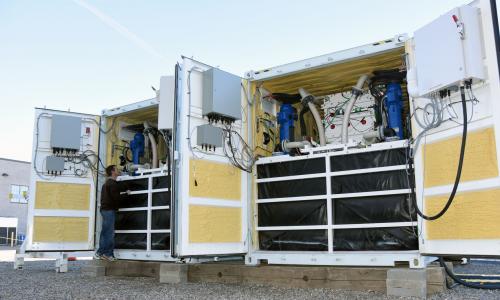Battery energy storage is a critical part of a clean energy future. It enables the nation’s electricity grid to operate more flexibly, including a critical role in accommodating higher levels of wind and solar energy. At the same time, it can reduce demand for electricity generated by dirty, inefficient fossil fuel power plants that harm local communities.
New energy storage projects usually consist of banks of lithium-ion batteries which can offer community benefits such as resiliency. But they may also raise questions related to health and safety for those living near these systems.
So what is community-scale storage? Are these batteries a fire hazard? Can lithium-ion batteries be recycled? You can find the answers to these and more frequently asked questions below.
1. What is the difference between customer-, community-, and utility-scale storage?
Lithium-ion battery storage can be grouped into two categories: behind-the-meter (BTM) storage systems, which are typically used with individual residential or commercial buildings, and front-of-the-meter (FTM) storage systems, which are usually much larger projects deployed by utilities. Community-level storage projects can be either BTM or FTM depending on the ownership, purpose/use, and operation of the batteries. (See question 4 for more on who owns the different levels of battery storage.)
BTM batteries can store and discharge electricity independently from the external electrical grid and are typically paired with rooftop solar panels at the residential level for households or for commercial or industrial customers. These relatively small-scale battery systems are often used for demand- side (electricity customer) management to decrease electricity bills and to provide backup power. Most BTM battery users are also connected to the utility grid and can draw conventional power when the battery is not being used.
Utility-scale batteries, also called FTM, grid-scale, or large-scale batteries, can be connected anywhere along the electricity grid from the point of power generation (think at a solar or wind farm), along the transmission network, or closer to the point of distribution of that electricity. These batteries increase flexibility in the grid allowing for more renewable energy penetration, reduce the need for investment in capacity from dirtier sources to meet peak energy demands, reduce the need for infrastructure investments in transmission and distribution, and provide relief to the grid to decrease chances for blackouts or brownouts.
Community-level storage batteries may be used for community centers, multifamily housing, or in some other aggregated form to provide benefits to more members of a community. The focus of storage at this level is often for the purposes of community resiliency (see question 2 on how it can do so).
2. Can battery storage help keep the power on during blackouts?
Yes, storage can contribute to local energy security and energy resilience, especially when the batteries are paired with local power source on a community microgrid. A microgrid is a small network of customers with a local source of electricity that can be disconnected from the grid and operated independently.
During and after natural disasters and extreme weather events, all of which are becoming more frequent with climate change, battery storage can help keep essential services running and protect the most vulnerable populations as part of a community-driven climate resilience plan. When thinking about community resilience, it can be advantageous for critical infrastructure—such as police and fire stations, hospitals, cooling centers, and emergency shelters—to have rooftop solar panels and battery storage systems on site to keep the power on during an emergency.
3. Does battery storage need to be physically located in a community to benefit the community?
Because of its flexibility, energy storage has the potential to benefit communities without being physically located in the communities it may serve.
By displacing fossil fuel–fired power plants battery storage can reduce air pollution and improve public health outcomes in the communities where those plants are located. Utility-scale storage can be charged from the grid without the need to be connected directly to any specific power plant. This offers flexibility in the siting and use of storage resources but presents complications in terms of ensuring optimal outcomes.
To maximize community and climate benefits, batteries must be charged when the grid is being supplied by cleaner electricity and discharge the stored electricity when the grid would otherwise be supplied primarily by dirtier sources. The grid is cleaner when renewable electricity generation is at its highest, especially at times when it would otherwise need to be wasted or curtailed (i.e., when a renewable energy resource must be “turned off” or diminished because its output exceeds grid demand at the time of peak renewable supply.) The grid tends to be dirtier during periods of peak demand, such as late afternoons on hot summer days, when backup generators powered by coal, natural gas, oil, or even diesel are turned on to meet demand.
This effect—charging with clean electricity and discharging to displace dirty resources—can be achieved through a combination of rooftop solar panels and BTM battery storage in homes or community centers (see question 1 about BTM storage), or when storage is installed alongside solar or wind farms. However, the effect can be achieved elsewhere along the electricity grid as well.
In short, energy storage in a variety of configurations can help bring more renewable energy deployment and drive public health and resiliency benefits. Good policy design focuses on when and how storage is charged and discharged, rather than a need for renewables and storage to be in the same place. Communities and stakeholders should be informed and help determine size and location of battery storage projects based on their desired goals or outcomes.
4. What options are possible for energy storage ownership?
Most large-scale or utility-scale energy storage systems are owned and operated by the local utility or an independent power company, sometimes taking advantage of state or local grants or federal incentives, though the community might have helped purchase the system through their electricity bills. Battery storage costs at all scales have decreased rapidly over the past few years, though they remain relatively expensive systems.
As battery storage becomes more affordable, utilities are beginning to pilot behind-the-meter home battery storage programs to add flexibility and reliability to the grid by retaining the ability to use the residential batteries as reserve power. This allows the utility to avoid paying for additional electricity elsewhere and pass those cost savings on to consumers. Homeowners also benefit by having backup power available in the event of an outage.
Other models are possible for renewable energy and energy storage ownership beyond utility ownership. For example, the Renewable Energy Partners microgrid project in a Northern Minneapolis community of color will serve as a multi-purpose training facility and resiliency hub, with the battery storage for the microgrid owned by the University of Minnesota’s Energy Transition Lab. Another is community choice aggregation, which is a model for local governments and their constituents to have more control over their energy systems, and that could include battery storage projects. Also, more projects are being modeled that benefit affordable housing complexes or low-income communities, such as the Marcus Garvey Apartments in Brooklyn, New York. That project is a microgrid that serves as a community resiliency center during power outages and is expected to result in cost savings on electricity and heating for residents.
5. What kinds of jobs are created and supported by energy storage projects?
Battery storage creates a variety of jobs, including software coding (e.g., designing programs to control and monitor battery charging cycles), manufacturing, installation, and maintenance. Since battery projects produce very few on-site jobs through system installation and maintenance, most of the jobs created can be located far from the storage facility. Policies can help encourage local job creation by prioritizing contracts for energy projects that hire workers from the nearby community.
Analysis from a global study estimated that 330,000 energy storage jobs will be created in North America by 2050, including in research and development, manufacturing, and installation. While the National Association for State Energy Officials’ 2020 U.S. Energy and Employment Report, details jobs and job growth across the energy sector for the United States.
Energy efficiency improvements (such as weatherization and insulation) create the most clean energy jobs locally, followed by solar deployment in communities. Energy efficiency employs 2.38 million people in the United States; and in 2019, 54,000 net jobs were created in energy efficiency and 10,900 created in renewable technologies.
6. Do lithium-ion battery storage facilities generate local air pollution?
Battery storage does not emit localized pollution that is harmful to human health. Indeed, battery storage systems can reduce air pollution from conventional power plants or emergency backup generators that burn gasoline, diesel, propane, or natural gas, by reducing the need for these resources (see question 3).
There are some climate-warming emissions associated with the mining, production, and assembly of battery systems. The magnitude depends largely on the sources of energy used in those processes. Also to be considered are the emissions associated with the electricity that is stored and then discharged from the batteries; coal-, oil-, and natural gas–fired electricity generation is a major source of carbon emissions, whereas solar, wind, hydro, geothermal, and other renewable electricity generation has zero emissions. Batteries can store energy from non-renewable fossil fuel energy sources as easily as from renewable sources, which points to the need for strong policy design that prioritizes clean energy development to maximize community and climate benefits (see question 3).
7. Are lithium-ion batteries a fire or chemical hazard?
They can be, but that hazard can be mitigated with proper attention, care, and disposal (see question 8 for more on recycling and disposal). Utilities and battery storage developers should meet or exceed the highest standards for fire safety.
Rechargeable lithium-ion batteries currently exist safely in homes and communities in numerous items, such as cell phones, laptops, and even toothbrushes. Large-scale battery storage, however, can pose higher risks of fire and explosion. These risks can be minimized, just as they are for any facility that produces, contains, or uses flammable materials (e.g., gas stations)—through proper federal and state regulation and on-site management.
Research has helped provide more information to the public and to manufacturers to prepare for potential hazards. For instance, batteries can create the potential for a fire hazard known as thermal runaway, which is when overheating of one battery cell causes the cells around it to overheat. That heat can spread throughout a battery pack, or across battery packs, to create an explosion. If the battery does catch fire, it can release toxic gases such as hydrogen fluoride, carbon monoxide, and hydrogen chloride. There is also a risk of toxic chemicals being released if the battery is damaged during disposal.
Manufacturers have built in safety measures like temperature sensors, voltage regulators, and separators to minimize the potential for thermal runaway. Nevertheless, continued attention should be paid to maximizing safety so that energy storage batteries can be used and disposed of with minimal risk to human and environmental health. For example, battery storage companies should inform local fire officials of the fire or explosive potential so that first responders can be prepared. The National Fire Protection Association 855 code provides a standard for the installation of stationary energy storage systems to mitigate risks for designers and installers of storage, as well as for first responders.
8. Where do critical materials for lithium-ion batteries come from?
A number of critical materials are rare but essential to the batteries used in household electronic devices, electric vehicles, and energy storage systems. Two in particular are essential for battery storage applications: lithium and cobalt.
Currently, much of the global supply of lithium is extracted from either Australia’s hard-rock mines or from reservoirs beneath dried-up lake beds in Chile, Bolivia, and Argentina. There are human rights, health, and environmental impact concerns with these two extraction processes because of the amount of associated carbon dioxide emissions, water use, and land use.
A third, relatively new process exists that has potential to meet lithium demand with minimal environmental impacts: direct lithium extraction from underground brines. Lithium-rich brines are already used in geothermal power plants to generate electricity. They represent an untapped source of domestic lithium for the United States and other countries. (Nearly all lithium used in the United States is imported.) This would allow the United States to not only stabilize supply chains and create more jobs, but also stay competitive in the global clean energy race.
There are other rare materials in lithium-ion batteries that contribute to international environmental justice concerns, including cobalt. Cobalt is primarily produced in the Democratic Republic of Congo where there are reports of child and slave labor as well as environmental damage. This points to the need for transparency and accountability in supply chains and corporate responsibility guidelines for battery manufacturing companies.
As battery storage will be an integral part of the clean energy future, securing the supply chain and being at the forefront of technological innovation for batteries is important for national energy security. In addition to a US supply of lithium and cobalt, it is important that the United States have fair labor standards and strong environmental standards to govern all critical material extraction processes. Equally essential is continued research and development to identify substitute materials or technologies (for example, zinc-air batteries) that could move battery production away from dependency on mining for critical materials, especially in places without environmental and labor standards or where human rights violations occur.
9. Can lithium-ion storage batteries be recycled?
Yes, they can be reused or recycled. Currently, however, it is complicated and expensive to do so, although research is ongoing.
Like other household rechargeable batteries and electronics waste, lithium-ion batteries for large-scale storage must be recycled or disposed of outside of the traditional waste stream because they can be flammable, explosive, or toxic to human or environmental health when not handled properly (see question 7).
There are currently many challenges with recycling lithium-ion batteries, given their varying chemical composition and the steps required to chemically and physically separate the component materials, and the market does not yet support robust recycling. However, that is beginning to change as the importance of these systems gains recognition and the circular economy around them grows. With a strong push at the federal level for domestically controlled lithium-ion battery supply chains, the Department of Energy’s Office of Energy Efficiency and Renewable Energy has a National Blueprint for Lithium Batteries. One of the blueprint’s five goals is to facilitate the large-scale reuse of batteries as well as the recycling of the critical materials within the United States.
10. Which stakeholders need to be involved when considering battery storage projects in a community?
There is no one-size-fits-all approach to developing an energy storage project in a community. Storage may be developed for community resiliency or installed at a larger scale to increase electricity grid flexibility and reliability or to replace peaker plants. Strong policies can help ensure that energy storage maximizes renewable energy development and community benefits. Policymakers, legislators, and regulators should work with communities and constituents to prioritize the greatest needs (air quality improvement, cost savings, resilience in extreme weather, etc.) and identify the scale and location of storage projects that will best meet those needs. Siting, ownership, funding, grid connections, maintenance, and other concerns must also be addressed before a project can get under way.
Having the following stakeholders at the table is key to a successful storage project:
- Neighborhood or community interest groups
- Building inspectors, firefighters, and state environmental regulators or permitting agencies to ensure safety requirements are met
- Municipal governments
- Developers and owners of storage systems
- Local utility
It is critical that energy storage project decisions address the needs of vulnerable residents of disadvantaged neighborhoods and frontline communities. UCS has developed a set of principles on equitable energy storage to help stakeholders focus on community-led clean energy solutions.
For more information on how energy storage works and the types of storage available, see our Energy Storage Explainer




